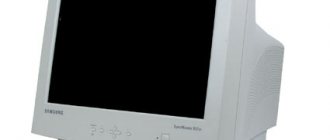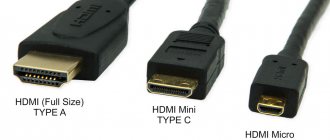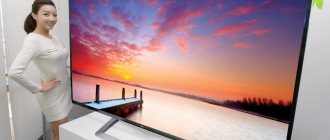When choosing a TV or home theater, the first question that worries future happy owners is the diagonal. Moreover, this term often refers to the overall size of the TV, the distance between opposite corners, including the frame. In fact, the diagonal is the size of the screen - the visible part of the matrix.
Traditionally, this size is indicated in inches, but for our users who are accustomed to the metric measurement system, a decoding is usually required.
TV diagonal in centimeters and inches: table
Considering that an inch is equal to 2.54 cm, it is not difficult to calculate the diagonal size in centimeters. However, for greater convenience, we present a table that contains popular TV diagonal values and the corresponding size value in centimeters.
It should be taken into account: data on popularity is taken based on the main search queries and, according to demand, the assortment of retail chains. Some non-standard sizes from individual manufacturers are not included in the table. In this case, you will have to use a simple formula:
A = 2.54 x B
where A is the diagonal size in centimeters, B is in inches.
Table 1. TV diagonals in English (inches) and metric (cm) systems.
| Value in inches | Value in centimeters | Value in inches | Value in centimeters |
| 7 | 17,78 | 48 | 121,92 |
| 15 | 38,1 | 49 | 124,46 |
| 18,5 | 46,99 | 50 | 127 |
| 19 | 48,26 | 52 | 132,08 |
| 20 | 50,8 | 55 | 139,7 |
| 21 | 53,34 | 58 | 147,32 |
| 22 | 55,88 | 60 | 152,4 |
| 23 | 58,42 | 65 | 165,1 |
| 24 | 60,96 | 70 | 177,8 |
| 27 | 65,78 | 75 | 190,5 |
| 28 | 71,12 | 77 | 195,58 |
| 29 | 73,66 | 78 | 198,1 |
| 32 | 81,28 | 79 | 200,66 |
| 39 | 99,06 | 80 | 203,2 |
| 40 | 101,6 | 82 | 208,28 |
| 42 | 106,68 | 84 | 213,36 |
| 43 | 109,22 | 85 | 215,9 |
| 45 | 114,3 | 86 | 218,44 |
| 46 | 116,84 | 98 | 248,92 |
| 47 | 119,38 | 100 | 254 |
Screen width and height data are generally provided as a guide only. This is due to the fact that most televisions are produced in the so-called widescreen version. The aspect ratio in such devices is 16:9.
How to convert inches to centimeters
The inch is a non-metric system, while centimeters are a metric system and are used to measure lengths. Inches are considered an outdated system, but they are still used in technology. A double stroke is used to indicate an inch.
To make choosing a TV easier, just convert inches to centimeters. One inch is equal to 2.54 centimeters. Accordingly, a 10-inch screen will be equal to 25.4 centimeters.
To make the translation easier, you can use a table or an online calculator.
TV diagonal in cm: side size table
Below are data on approximate screen sizes for popular diagonals. For convenience, dimensions are offered in inches and centimeters, rounded.
Table 2. Dependence of screen width and height on the TV diagonal.
| Diagonal in inches | Diagonal in cm | Height | Width | ||
| inches | cm | inches | cm | ||
| 19 | 48 | 16,5 | 42 | 9,3 | 24 |
| 21 | 53 | 18 | 46,5 | 10 | 26 |
| 22 | 56 | 19 | 49 | 10 | 27,5 |
| 24 | 61 | 21 | 53 | 12 | 30 |
| 28 | 71 | 24,5 | 62 | 14 | 35 |
| 32 | 81 | 28 | 71 | 16 | 40 |
| 40 | 102 | 35 | 86 | 20 | 50 |
| 43 | 109 | 38 | 95 | 21 | 53,5 |
| 49 | 124 | 43 | 108 | 24 | 61 |
| 50 | 127 | 44 | 111 | 24,5 | 62 |
| 55 | 140 | 48 | 122 | 27 | 68 |
| 58 | 147 | 50,5 | 128 | 28 | 72 |
For televisions whose data is not given in the table, you can calculate the approximate height and width of the screen using the well-known formula - the Pythagorean theorem.
When applied to a screen for which usually only the diagonal and aspect ratio (16:9) are known, it is necessary to calculate the size of the fraction (since the height and width are in the ratio of 16 to 9, the total number of fractions is 25). So the square root of
C2 = a2 + b2C = √(a2+b2)
For a right triangle with a conditional height of 9 and a width of 16, the diagonal will be equal to
√(92+162) = √(81+256) = 18,36
Then for a 40-inch TV, the ratio of the real size to the diagonal of the conditional triangle will be
40/18,36 = 2,17
The same will be the ratio of height or width to the conventional 9 and 16 parts:
9x2.17=19.6 and 16x2.17=34.72.
By comparing with the rounded values in the table - 30 and 35 - you can verify the correctness of the calculations.
Thus, for any diagonal size (in inches or centimeters/millimeters), it is enough to determine the ratio of the real diagonal to the conditional one (18.36) and then, using a certain ratio, find the height and width of the screen.
How to measure the diagonal of a TV
When choosing a TV, most users measure the screen incorrectly. They believe that its size is its distance in width, from one edge to the other. This is far from true. After all, a diagonal in a rectangle is a line drawn from the bottom edge of one side to the top edge of the other side. Example: distance from the bottom left corner of the display to the top right. Moreover, the measurement is carried out only on the matrix itself, without taking into account the frames of the TV. There is also this nuance: TV manufacturers, especially Chinese companies, leave a black edge in the matrix on some of their models, which does not reproduce images. However, they do not cover this dark area with a frame. Thus, before turning on the TV, the screen may appear much larger than it actually is.
Another nuance lies in determining the display size in curved TVs. Difficulties will arise with its measurement only when using a tape measure. An ordinary tape centimeter, which is twisted by hand, like a skein of some kind of tape, will help out here. It is elastic, so it will not damage the screen.
It is much more difficult to determine the distance for comfortable viewing on a modern curved TV. The point here is this: if you take a regular TV and one with a curved matrix, it turns out that the curved TV model will be somewhat narrower, despite the same display size. Here the usual calculation of a distance of 3-4 diagonals will not be relevant. And you will need to determine the distance for comfortable viewing based on the width of the screen. You just need to measure the width of the curved model in the store, and then compare the resulting measurements with the width of a regular TV. This is easy to do, since the data on the display diameter for conventional models is already known.
| Screen in inches | Screen width in centimeters |
| 32 | 70 |
| 40 | 88 |
| 42 | 95 |
| 50 | 110 |
| 55 | 121 |
| 60 | 132 |
| 65 | 143 |
| 75 | 166 |
Knowing the width of the display depending on its dimension, you can easily compare this data with the width of the curved TV. Information about the width, diagonal and required distance at which conventional TVs should be located (will be presented below) is known. Therefore, determining this very distance in models with a curved screen will not be difficult.
What is more important: prestigious size or ease of use
When choosing the sizes of TV diagonals in cm (Tables 1 and 2), the user often, in pursuit of the maximum size, forgets whether it will be convenient to watch programs and films on such a device.
Experts recommend:
- choose the size of the TV depending on the size of the room. For a kitchen or bathroom whose area does not exceed 6...8 sq.m., you should not buy models with a screen larger than 19...20 inches;
- take into account the distance from the screen to the viewing position. Traditionally, it should be at least 3 heights of the visible part of the matrix. Another option is that the distance should be three diagonals;
- relate the matrix size to the screen resolution. The lower the resolution, the smaller the screen must be - otherwise the image breaks up into pixels;
- choose the distance depending on the viewing angle. It is believed that the involvement of peripheral vision (viewing angle greater than 20 degrees) enhances the “effect of presence” when viewing a video sequence.
Thus, there are two ways to optimally select the size of a TV. The first is to select the maximum allowable diagonal based on the known dimensions of the room and the location of the viewer, as well as the nature of the video broadcasts. The second is to choose a place for the viewer/viewers, taking into account the desired screen size.
LG Technologies
Each manufacturer tries to stand out from competitors not only with marketing tricks, but also with technological advances.
NANO Cell
LG offers innovation Nano Cell - nanocells. They make the color rendition “more correct”, corresponding to what the author intended, even when viewed from an angle. It consists in absorbing excess light radiation, which prevents color distortion and a number of negative effects that reduce the brightness and accuracy of color rendering.
TVs with Nano Cell have cells measuring 1 nm. They show a clearer, more detailed image, more accurately convey color and increase the viewing angle. A special thin-film coating on top of the matrix absorbs a certain glow, increasing color accuracy. To increase the viewing angle, Nano Cells are combined with IPS matrices, where there is virtually no color degradation at any view.
Unfortunately, this technology is not up to par with OLED. Essentially it's just a filter with an IPS matrix. Remember that IPS panels are darker than VA* panels. And some micro areas in dark scenes may not be displayed. It’s better to come to the store and understand whether you like the picture or not.
OLED (with self-illuminating pixels)
The technology involves eliminating the use of a filter through which the backlight light is passed. As a result, the pixels can emit light individually, guaranteeing a rich color palette, enviable contrast and clearly visible textures.
If you want a premium picture, you are welcome to OLED.
HDR – what is it, what does it give
Most TVs support HDR. To implement the technology, you need “double brightness” - from 1000 nits and a 10-bit matrix with local backlighting. HDMI generation 2a is required to receive relevant content.
Cheap modules are equipped with an improved 8-bit 8bit + FRC matrix and a normal brightness of around 400 nits. Such devices support HDR only “on paper”; the effect of such implementation is negligible, and the inscription on the box or in the specifications is a marketing ploy.
A unified HDR standard has not been developed; there are TVs that support:
- HLG (Hybrid Log Gamma) is a signal compatible with SDR and HDR. Supported by all SDR receivers. There is very little relevant content yet.
- Advanced HDR is a range of formats created by Technicolor that are backward compatible with SDR. There is also almost no content yet.
- Dolby Vision is the most technologically advanced format, using 12-bit color depth with 70 billion shades. Due to the presence of a license, it is found in premium TV receivers.
- HDR10 is a leading open source technology. With 10-bit color it shows 1 billion shades. Disadvantage – static metadata, advantage – more than 95% of content is designed for HDR
- HDR10+ is a 10-bit licensing-free alternative to Dolby Vision. Applies dynamic metadata.
As a result, HDR is an expanded color space, increased brightness (about two times compared to SDR) and picture detail.
Screen sizes and TV dimensions
Since manufacturers of video playback devices indicate the screen diagonal in the description, buyers sometimes make mistakes when calculating the space required to accommodate the model. This is especially significant when the TV is located in a niche of a furniture wall or between furnishings.
Important: before purchasing, you should check with the seller about the overall dimensions of the device. Moreover, in the case of installation on a tabletop stand, the dimensions take into account the stand. If the flat panel is mounted on the wall, you should first find out the dimensions of the fastening element and determine the increase in the required depth of the niche.
Ports
TVs are equipped with both promising and outdated interfaces for receiving signals.
- HDMI - a pair of interfaces is required in any receiver that you plan to use as a monitor or screen for a game console. To transmit 4K at 60 frames per second, you need HDMI 2nd generation.
- USB – used to connect portable storage devices for the purpose of playing or recording content on them. To watch movies in 4K resolution, you need USB0.
- S/PDIF – needed for pairing with speaker systems.
- LAN (Ethernet) – needed for a wired connection to a router (Internet, home network).
- The Wi-Fi module is a way to play content from the Internet or network storage.
- Bluetooth – used for connecting peripherals: mouse, gamepad, keyboard.









